
The Agaricales are an order of fungi in the division Basidiomycota. As originally conceived, the order contained all the agarics, but subsequent research has shown that not all agarics are closely related and some belong in other orders, such as the Russulales and Boletales. Conversely, DNA research has also shown that many non-agarics, including some of the clavarioid fungi and gasteroid fungi belong within the Agaricales. The order has 46 extant families, more than 400 genera, and over 25,000 described species, along with six extinct genera known only from the fossil record. Species in the Agaricales range from the familiar Agaricus bisporus and the deadly Amanita virosa to the coral-like Clavaria zollingeri and bracket-like Fistulina hepatica.

Fungus-growing ants comprise all the known fungus-growing ant species participating in ant–fungus mutualism. They are known for cutting grasses and leaves, carrying them to their colonies' nests, and using them to grow fungus on which they later feed.

The ant–fungus mutualism is a symbiosis seen between certain ant and fungal species, in which ants actively cultivate fungus much like humans farm crops as a food source. There is only evidence of two instances in which this form of agriculture evolved in ants resulting in a dependence on fungi for food. These instances were the attine ants and some ants that are part of the Megalomyrmex genus. In some species, the ants and fungi are dependent on each other for survival. This type of codependency is prevalent among herbivores who rely on plant material for nutrition. The fungus’ ability to convert the plant material into a food source accessible to their host makes them the ideal partner. The leafcutter ant is a well-known example of this symbiosis. Leafcutter ants species can be found in southern South America up to the United States. However, ants are not the only ground-dwelling arthropods which have developed symbioses with fungi. A similar mutualism with fungi is also noted in termites within the subfamily Macrotermitinae which are widely distributed throughout the Old World tropics with the highest diversity in Africa.

The Tricholomataceae are a large family of fungi within the order Agaricales. Originally a classic "wastebasket taxon", the family included any white-, yellow-, or pink-spored genera in the Agaricales not already classified as belonging to e.g. the Amanitaceae, Lepiotaceae, Hygrophoraceae, Pluteaceae, or Entolomataceae.
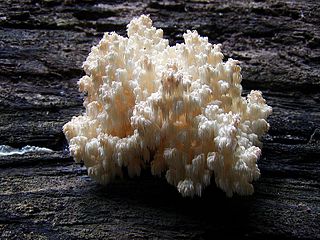
Hericium is a genus of edible mushrooms in the family Hericiaceae. Species in this genus are white and fleshy and grow on dead or dying wood; fruiting bodies resemble a mass of fragile icicle-like spines that are suspended from either a branched supporting framework or from a tough, unbranched cushion of tissue. This distinctive structure has earned Hericium species a variety of common names—monkey's head, lion's mane, and bear's head are examples. Taxonomically, this genus was previously placed within the order Aphyllophorales, but recent molecular studies now place it in the Russulales.

Aphanobasidium is a genus of corticioid or crust fungi in the Radulomycetaceae family. The genus has a widespread distribution and contains several species. This genus was formally considered to be part of the Pterulaceae family.
Parapterulicium is a genus of fungi in the order Russulales. The genus contains two species found in Brazil and Argentina.
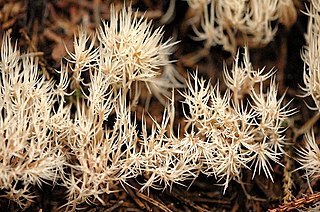
Pterula is a genus of fungi in the Pterulaceae family. The genus has a widespread distribution, especially in tropical regions, and contains about 50 species. One such species, Pterula sp. 82168, has yielded potential antifungal antibiotic properties.
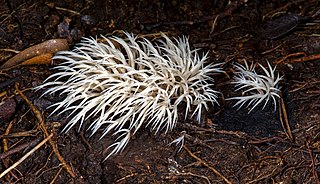
Pterulicium is a genus of fungi in the Pterulaceae family. The genus was previously monotypic, containing the single species Pterulicium xylogenum, found in southeast Asia. However in 2020 a major reclassification of the Pterulaceae family occurred based on phylogenetic analysis and the Pterula genus was split into Pterula, Myrmecopterula, Pterulicium and Phaeopterula by the mycologists Caio A. Leal-Dutra, Bryn Tjader Mason Dentinger and Gareth W. Griffith.
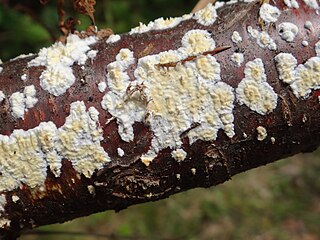
Radulomyces is a genus of crust fungi in the family Radulomycetaceae. The genus has a widespread distribution and contains 11 species. It was circumscribed by Danish botanist Mads Peter Christiansen in 1960, with Radulomyces confluens as the type species. This genus was formally considered to be part of the Pterulaceae family.

Myrmecopterula is a genus of fungi in the family Pterulaceae. Basidiocarps are clavarioid and are associated with ant domestication by members of the genus Apterostigma.

Myrmecopterula moniliformis is a species of fungus in the family Pterulaceae and is the type species of the genus Myrmecopterula. It is associated with fungi cultivating ants of the genus Apterostigma.
Myrmecopterula velohortorum is a species of fungus in the family Pterulaceae. It is associated with fungi cultivating ants of the genus Apterostigma.
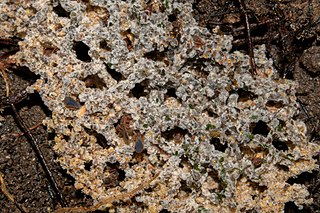
Myrmecopterula nudihortorum is a species of fungus in the family Pterulaceae. It is associated with fungi cultivating ants of the genus Apterostigma.

The Radulomycetaceae are a family of fungi in the order Agaricales.
Phaeopterula is a genus of fungi in the family Pterulaceae. Basidiocarps are clavarioid and resemble species of Pterula.
Radulotubus is a monotypic genus of corticioid or crust fungi in the family Radulomycetaceae containing the single resupinate species Radulotubus resupinatus. This species was found in Yunnan province, China and formally classified in 2016. The specimen was found growing on the fallen trunk of an angiosperm. It was originally placed in the family Pterulaceae and noted to be closesly related with Aphanobasidium and Radulomyces.
Pterulicium caricis-pendulae is a species of mushroom producing fungus in the family Pterulaceae. It has the common name pendulous sedge club.
Pterulicium gracile is a species of mushroom producing fungus in the family Pterulaceae.












